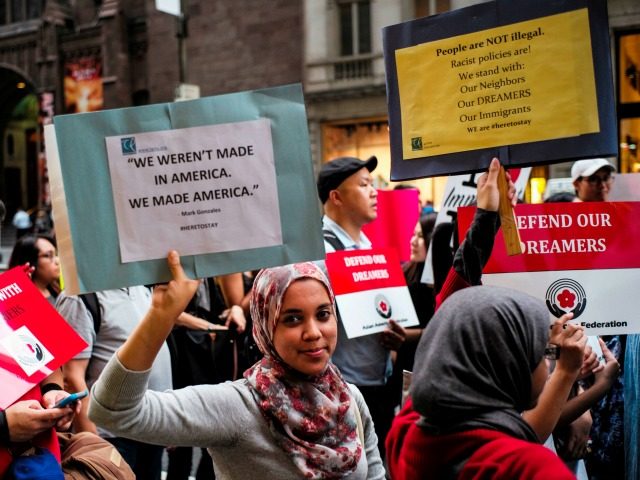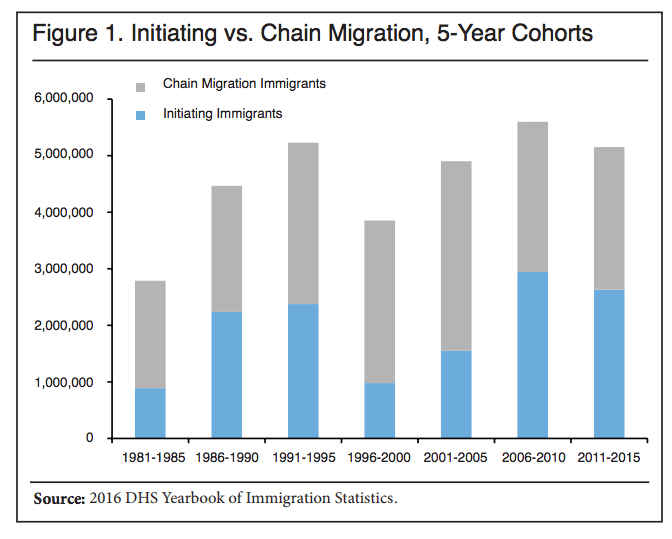A White House official has floated a compromise on chain migration which critics say will leave conservatives empty-handed several years after a ‘Dream Act’ amnesty is passed.
The proposal came at the last moment of an October 8 evening teleconference describing on President Donald Trump’s popular immigration principles. One of several White House officials on the call ended the call by saying they planned to oppose the award of citizenship to young illegals. “As we look to legalizing the status of DACA recipients, we are not interested in granting citizenship,” said the official.
Citizenship is a key issue for Democrats and Republicans because new citizens are entitled to vote and to bring homeland relatives into the United States and then get them into the polling booth five years later. That citizenship-enabled chain-migration of government-dependent voters is responsible for more than half of immigration since the 1980s and has given Democrats full or partial control of several states, including California and Virginia.
Chain migration has also been a boon for business groups because the increased population has expanded sales, revenues and profits.
But it has been a disaster for conservatives and the GOP, which is now almost locked out of state-wide politics in California, and for American employees in the labor marketplace.
The suggestion by the White House official for a legalization-but-no-citizenship deal “is basically trying to trick the American people into thinking that you are not … setting it up for the full-scale amnesty later,” said Roy Beck, president of NumbersUSA. Denying a path to citizenship would just “be kicking the [chain-migration] can down the road until Democrats get control of Congress again,” he said.
Any political gains from the temporary denial of citizenship won’t last beyond the next Democratic majority in the Senate or House, said Jessica Vaughan, policy director at the Center for Immigration Studies. It won’t last because Americans can’t tolerate a second-class status for long-term residents, even if they are former illegal immigrants, she said.
Moreover, if White House officials offered to give up a core element of Trump’s immigration reforms — such as a needed reductions in chain-migration — in exchange for legalization-but-not citizenship, Democrats would pocket the legalization immediately and pick up the citizenship and chain-migration later, she said. The deal would be a complete loss for the Republicans, she said, adding “Democrats would laugh at the stupidity of [the GOP for] actually pursuing that.”
In his October 8 letter announcing his immigration policy, Trump said a fix for the chain-migration problem must be included in any deal. He wrote:
As President, I took an oath to uphold the Constitution, which makes clear that all legislative powers are vested in the Congress, not the President.
I, therefore, tasked the relevant executive departments and agencies to conduct a bottom-up review of all immigration policies to determine what legislative reforms are essential for America’s economic and national security … These findings outline reforms that must be included as part of any legislation addressing the status of Deferred Action for Childhood Arrivals (DACA) recipients. Without these reforms, illegal immigration and chain migration, which severely and unfairly burden American workers and taxpayers, will continue without end.
Immigration reform must create more jobs, higher wages, and greater security for Americans — now and for future generations. The reforms outlined in the enclosure are necessary to ensure prosperity, opportunity, and safety for every member of our national family.
Trump has already endorsed the RAISE Act, drafted by Georgia Sen. David Perdue and Arkansas Sen. Tom Cotton. That law would shrink chain-migration by allowing new immigrants to only win residency for their spouses and minor children.
Some legislators in by the GOP’s business-first wing, including North Carolina Thom Tillis and Oklahoma Sen. James Lankford, are pushing a claimed DACA-amnesty compromise that would supposedly stop a subsequent wave of chain-migration Democratic-voters. Their legislation delays citizenship for 15 years, and so postpone the arrival of Democratic-voting chain-migrants until the end of Tillis’ political career.
But their 15-year delay will be countered by courtroom advocates and by campaigning Democrats, who have put only a five-year or a three-year delay in their otherwise similar Dream Act. Both bills would offer amnesty, work permits and citizenship to more than 2 million illegals — most of whom would also try to win citizenship for their illegal-immigrant parents in the country and other relatives outside the country.
In September, Breitbart News spoke to illegal immigrants protesting outside the White House and asked if they would accept curbs on migration to win an amnesty. “I think no,” said Yoseline R. said. She added that she declined to set limits on immigration because she is concerned for members of her family outside the United States. Natalie H., who said she is a Mexican, said Americans’ annual immigration limits should grow because foreign people want to “come here for a better life.”
The only way to prevent a DACA deal from delivering another huge wave of migrants into the United States is a deal which curbs chain-migration for every new citizen, including the DACA illegals, fairly and equally, Vaughan said.
A half-solution — such as special rules for the DACA illegals — can’t survive elections or courtrooms, Vaughan said. “I think that would be a political mistake to do it halfway [because] opens Republicans up to constant derision about Jim Crow status for people with DACA residency,” she said.
Second-class treatment for the amnestied DACA illegals “is not a good idea anyway if you are going to make them permanent residents of the country,” said Beck. “If you think amnesty is going to happen, it would have to be citizenship amnesty.”
The only way to solve the chain-migration problem, said Beck, is “you end chain migration for all immigrants.”
“We’ve had seven amnesties and every one has created chains of immigrants,” he said, adding ” we cannot do this again.”
In her September 2017 report, “Immigration Multipliers: Trends in Chain Migration,” Vaughan showed how chain migration has more than doubled the inflow of migrants, who are desired by companies as lower-wage employees and as welfare-using consumers. She wrote:
Over the last 35 years, chain migration has greatly exceeded new immigration. Out of 33 million immigrants admitted to the United States from 1981 to 2016, about 20 million were chain migration immigrants (61 percent).
• Judging from preliminary administrative data, approximately 1,125,000 legal immigrants were approved for admission in 2016, which is about 7 percent higher than 2015, and one of the highest numbers in the last decade.
• The largest categories of chain migration are spouses and parents of naturalized U.S. citizens because admissions in these categories are unlimited by law.
• According to the most complete contemporary academic studies on chain migration, in recent years each new immigrant sponsored an average of 3.45 additional immigrants. In the early 1980s, the chain migration multiplier was 2.59, or more than 30 percent lower.
• Of the top immigrant-sending countries, Mexico has the highest rate of chain migration. In the most recent five-year cohort of immigrants studied (1996-2000), each new Mexican immigrant sponsored 6.38 additional legal immigrants.
Vaughan’s report included this graphic:
In the Sunday phone call, a second White House official passionately set out the political case for Trump’s reforms, which include a real fix for chain-migration. The official said:
The question is what ought to be the priority for Congress? The priority for Congress ought to be to save American lives, protect American jobs, and to improve the well-being of American communities. These reforms accomplish that.
They live up to the president’s campaign commitments to have an immigration system that puts the needs of hardworking Americans first, and so you will see when you get these documents they deal with issues that are of vital importance to community safety and economic security, whether it be protecting low-income African-American and Hispanic workers from unfair displacement, preventing the release of dangerous criminals aliens in our sanctuary cities, closing glaring loopholes in our borders through rules on Unaccompanied Alien Children and asylum reform, ending a system of chain migration that depresses wages and increases unemployment.
We would expect Congress to include all of these reforms in any package that addresses the possible status of DACA recipients, so that we ere ending illegal immigration and we are solving the problem of chain migration once and for all, which is what the American people voted for, in the House, in the Senate and the Presidency, and the other views had their fair day in the democratic process, and the American people voted for the reforms outlined in this package.
Four million Americans turn 18 each year and begin looking for good jobs in the free market.
But business groups have used their political power to tilt the labor market in their favor, via the federal policy of importing 1 million consumers and workers each year. The government also hands out almost 3 million short-term work permits to foreign workers. These permits include roughly 330,000 one-year OPT permits for foreign graduates of U.S. colleges, roughly 200,000 three-year H-1B visas for foreign white-collar professionals, and 400,000 two-year permits to DACA illegals. Universities employ roughly 100,000 foreign guest workers.
That Washington-imposed economic policy of mass-immigration floods the market with foreign labor, spikes profits and Wall Street values by cutting salaries for manual and skilled labor offered by blue-collar and white-collar employees. It also drives up real estate prices, widens wealth-gaps, reduces high-tech investment, increases state and local tax burdens, hurts kids’ schools and college education, pushes Americans away from high-tech careers, and sidelines at least 5 million marginalized Americans and their families, including many who are now struggling with opioid addictions.
The cheap-labor policy has also reduced investment and job creation in many interior states because the coastal cities have a surplus of imported labor. For example, almost 27 percent of zip codes in Missouri had fewer jobs or businesses in 2015 than in 2000, according to a new report by the Economic Innovation Group. In Kansas, almost 29 percent of zip codes had fewer jobs and businesses in 2015 compared to 2000, which was a two-decade period of massive cheap-labor immigration.
Americans tell pollsters that they strongly oppose amnesties and cheap-labor immigration, even as most Americans also want to favor legal immigrants, and many sympathize with illegals.
Because of the successful cheap-labor strategy, wages for men have remained flat since 1973, and a growing percentage of the nation’s annual income is shifting to investors and away from employees. The business-funded Hamilton Project suggests that the shift is transferring $1 trillion per year from 160 million employees to the nation’s investors.


COMMENTS
Please let us know if you're having issues with commenting.